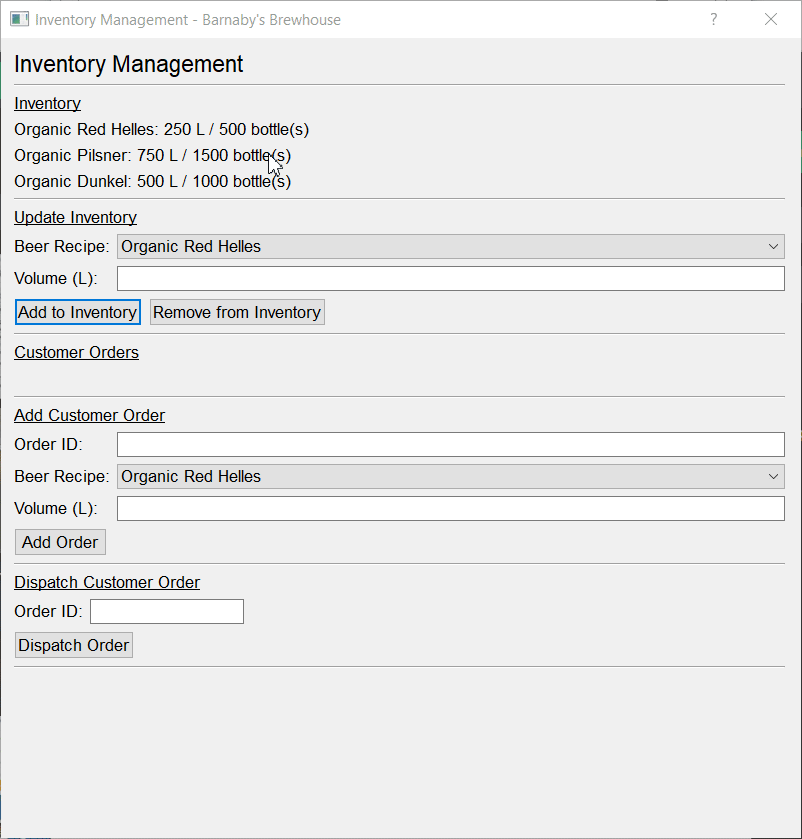brewhouse-management
A desktop application developed in Python with PyQt5 to predict demand and help monitor and schedule brewing processes for Barnaby's Brewhouse.
Visuals
Installation
These instructions will help you to get the software for Barnaby's Brewhouse running on your computer.
Operating System
Compatible with:
- Windows
- MacOS
- Linux
Python Version
Python 3.7.0 or later is required for this software to run. It can be downloaded from Python's website here.
Running the Application
To run the application, you should follow the following steps:
- Clone this GitHub repository.
- Ensure that you're in the root directory:
brewhouse-management - Install the required Python libraries:
pip install -r requirements.txt - Run the application with the command:
python -m src.app
Usage
Main Window and Sales Predictions
After running the application, you'll be presented with the total sales, sales ratios, and average monthly growth percentages from the existing sales data. You can predict sales by entering a month, and the software will display an estimate of the volume of each beer which will be ordered that month based on the average monthly growth in sales for each beer. It will also give advice on which beer should be produced next, based on which beer has the largest volume deficit. This advice can be useful when managing the production process in the Process Monitoring section of the software.
At the top, you can navigate to other sections of the software; there are buttons to navigate to inventory management and process monitoring.
Inventory Management
The Inventory Management button will open a dialog which displays the current inventory of each beer in Barnaby's Brewhouse in terms of both volume and number of 500 ml bottles. You can also add or remove volume of a given beer by selecting the beer recipe and volume, then clicking on a button to Add to Inventory or Remove from Inventory. The application intentionally allows negative volumes so that debts of volumes can be accounted for. The inventory manager automatically saves whenever the user makes changes.
Customer orders can be added in from the Inventory Management section as well. The user can add an order ID, beer, and volume to record the customer order. Once they've dispatched the order, they can record the dispatch by entering the order ID, which will remove the volume of the appropriate beer from the inventory of the brewhouse.
Process Monitoring
The Process Monitoring button will open a dialog which displays the availability of tanks for fermentation and conditioning, and ongoing brewing processes. You can start different brewing processes as long as any prerequisite processes have been completed for the appropriate beer and volume at the time.
Starting a hot brew does not have any prerequisites. Fermentation has the prerequisite of a completed hot brew. Conditioning has the prerequisite of completed fermentation. Bottling has the prerequisite of completed conditioning.
Once a valid process has been entered and started, it will be shown in the list of ongoing processes. From here, you can see the type of process, beer recipe it is being performed on, the tank it uses (if applicable), volume, and completion time. The ongoing process list is always up to date, and it will react to a process as it is started or aborted. This can be useful for checking whether you will be able to start the next process, as you can see whether the prerequisite process has been completed.
Processes can be aborted by entering the exact details of the process you would like to abort. Aborting a process cannot be undone, so all details of that process must be entered, as this will reduce cases of accidental process abortions.
When the bottling has been completed, it means that the full beer brewing process has been completed. You can send completed bottles to the inventory by clicking on the Send Bottles to Inventory button in the Ongoing Processes section. This will remove the completed bottling process, and add the volume of beer to the inventory, which can be seen in the Inventory Management section of the software.
The application automatically saves all changes made in the Process Monitoring section.
Upload Sales Data
The Upload Sales Data button will open a small dialog which provides a form for the user to input the details of their new sale. Once they click the Upload New Sale button, the form will be checked. If all the fields have been filled in, the new sale will be added to the CSV file.
Tools Used
Qt Creator was used to design the user interfaces for this project in a what you see is what you get (WYSIWYG) editor.
PyQt5's pyuic5 was used to generate the base Python code from the user interface designs, effectively converting the .ui files to .py files. I edited the generated code to conform to PEP 8 guidelines, and added documentation to make the code easier to understand. These generated code files are marked with the _setup.py suffixes, such as brewhouse_setup.py, and they were imported into the other Python files such as app.py so that functionality could be developed for the user interface objects.








